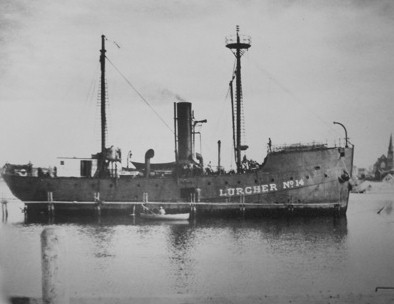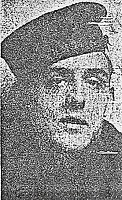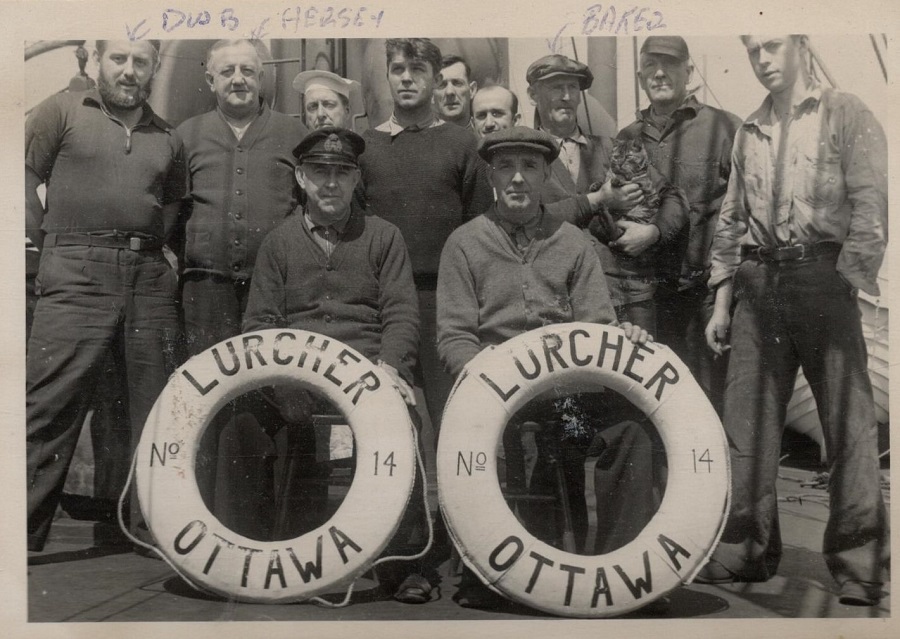|
Lucher Lightship
Lightship No. 14
Lightship No. 14 on station at the Lurcher. In 1944 she was moored about 2.5 miles southwestward from the 1.25 fathom (2m2) patch on the Southwest Shoal.
SHIPS' HISTORY: excerpt from Lightships on the Lurcher by Bill Day
Before the era of navigation by global positioning systems, mariners tended to treat landmarks off the coast of Yarmouth County with caution and respect. Seal and Mud Islands were situated west of Cape Sable and south of the Tusket Islands. Gannet Rock and Green Island lay south of Cape Forchu, while to its west the Lurcher Shoal interfered with travel to New England or to the Bay of Fundy. West of Port Maitland, Trinity Ledge hindered passage north to St. Mary’s Bay. Off Brier Island was Gull Rock, ever ready to ambush the unlucky or unwary.
Lurcher Shoal lies about 13 miles offshore of Yarmouth and comprises two separate shoal heads. Southwest Shoal, the larger of the two, with a least depth of 1.25 fathoms (2m2), is situated about 14.5 miles westward from Cape Forchu. From the shoal a bank with depths of less than 10 fathoms (18m3) extends about 1.5 miles northward and half a mile southward; there is considerable tide-rip over the northern part of this bank. Northeast Shoal, with a depth of 4.5 fathoms (8m2), lies about 2.5 miles north-northeastward from Southwest Shoal; uneven ground, with in places depths of from 7 to 10 fathoms (12m8 to 18m3), over which there are tide-rips, extends about a mile northward and three quarters of a mile southward of this shoal.
“When, in 1903, the Board of Trade at Saint John, NB, requested that a light vessel be stationed on the Lurcher shoals, it was to Polson of Toronto that the contract was entrusted.
“In the event, two vessels were ordered, the first to protect the approaches to the Bay of Fundy at the Lurcher shoal, the second to be moored off the northeast coast of Anticosti Island. The new lightships were 112 feet long, were built of steel, and had two masts and no bowsprit; in common with most steamers of the day, they carried a jury rig of fore and aft sails, but they were fitted with propelling machinery of reasonable power. Best of all, they had oversize mushroom anchors and Lloyds tested stud link cable fitted in a generous hawse pipe merging into the stem. The lights were electric, comprising seventh order lenses at each masthead and showed an occulting light visible at 13 miles from all points of approach. The foghorn was a compressed air diaphone, supported by a steam whistle as ‘second wind’ and a bell was provided in case the wind instruments became inoperative. In February 1904 the Lurcher light vessel was placed on station.”
They shall not be forgotten
Photos and Documents
Crew of Lurcher Lightship - Lightship # 14
From the collection of Douglas Berringer
Courtesy of Bethaire Mackinnon
Doug Berringer - standing, 1st on left
|



